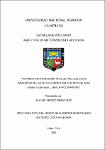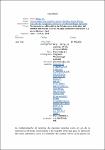Mostrar el registro sencillo del ítem
Temperatura radiométrica de follaje como indicador del estatus hídrico del cultivo de papa (Solanum tuberosum L.) en La Molina - Perú
| dc.contributor.advisor | García Villanueva, Jerónimo | |
| dc.contributor.advisor | Ramírez Collantes, David Antonio | |
| dc.contributor.author | Rinza Díaz, Javier Isidoro | |
| dc.date.accessioned | 2019-01-02T19:08:43Z | |
| dc.date.available | 2019-01-02T19:08:43Z | |
| dc.date.issued | 2018 | |
| dc.identifier.other | P40.R555-T BAN UNALM | |
| dc.identifier.uri | https://hdl.handle.net/20.500.12996/3773 | |
| dc.description | Universidad Nacional Agraria La Molina. Escuela de Posgrado. Maestría en Meteorología Aplicada | es_PE |
| dc.description.abstract | La implementación de técnicas de medición remotas como el uso de la radiometría infrarroja (termometría y termografía infrarroja) para la detección del cierre estomático como una medición del estatus hídrico de la planta con bajos déficit de presión de vapor (< 2 kPa) como la costa central del Perú, han sido discutidos en el presente estudio. Se llevaron a cabo dos experimentos, el primero realizado en macetas con el objetivo de identificar en qué momento del día la diferencia de temperatura de hoja y el aire (dT) y la conductancia estomática máxima a luz saturada (gs_max) reflejan mejor el estatus hídrico de la planta. Dicho experimento se llevó a cabo en plantas bien regadas (capacidad de campo, CC) y bajo restricción hídrica (50% CC). El segundo experimento fue llevado en campo, donde se evaluó el índice de estrés hídrico del cultivo (CWSI) con la metodología de la superficie de referencia y con el objetivo de establecer umbrales de riego. Se aplicarón tres tratamientos de riego: uno bajo condición de control (T1, CC) y otros dos con un umbral preestablecido de gs_max (0.15 [T2] y 0.05 [T3] mol H2O m-2 s-1). Se detectó una sensibilidad al cierre estomático con una caída de gs_max (gs) provocado por la intensificación de las condiciones meteorológicas en horas de la mañana. El cierre estomático intenso causó un incremento de dT que mostró valores positivos más altos (> 2 °C) después de gs. La significativa reducción en el rendimiento de T2 en relación al control (-38.2 ± 10.7 %) se recomienda usar valores de gs_max> 0.15 para garantizar un buen rendimiento. Esta investigación, propone el umbral de 0.4 de CWSI para establecer el momento adecuado para el riego en papa con evaluaciones tomadas alrededor de las 14:00 horas, tiempo en que permite una detección apropiada de las emisiones térmicas. | es_PE |
| dc.description.abstract | The implementation of remote measurement techniques such as the use of infrared radiometry (infrared thermometry and thermography) for the detection of stomatal closure as a measure of the water status of the plant in an environment humid conditions with low vapor pressure deficit (< 2 kPa) the central coast of Perú, have been discussed in the present study. Two experiments were carried out, the first carried out in pots with the objective of identifying at which time of the day the leaf and air temperature difference (dT) and the maximum, saturated-light stomatal conductance (gs_max,) better reflects the water status of the plant. This experiment was carried out in well-watered plants (field capacity, CC) and under water restriction (50% CC). The second experiment was carried out in the field, where the crop water stress index (CWSI) was evaluated using the reference surface methodology with the objective of establishing irrigation thresholds. Three treatments were apllied: one under control condition (T1, CC) and another two with a pre-established threshold of gs_max (0.15 [T2] and 0.05 [T3] mol H2O m-2 s-1). A sensitivity to stomatal closure was detected with a drop of gs_max (gs) caused by the intensification of weather conditions in the morning hours. Intense stomatal closure caused an increase in dT that showed higher positive values (> 2 °C) after gs. The significant reduction in the yield of T2 in relation to the control (-38.2 ± 10.7 %) proposes to use values of gs_max > 0.15 must be used to warrant a good yield. In the present study, the CWSI threshold 0.4 is proposed to establish the moment right for irrigation in potato with assessments taken around 2:00 pm, time in which it allows an appropriate detection of thermal emissions. | en_US |
| dc.description.uri | Tesis | es_PE |
| dc.format | application/pdf | en_US |
| dc.language.iso | spa | es_PE |
| dc.publisher | Universidad Nacional Agraria La Molina | es_PE |
| dc.rights | info:eu-repo/semantics/openAccess | en_US |
| dc.rights.uri | https://creativecommons.org/licenses/by-nc-nd/4.0/ | * |
| dc.source | Universidad Nacional Agraria La Molina | es_PE |
| dc.source | Repositorio institucional - UNALM | es_PE |
| dc.subject | Solanum tuberosum | es_PE |
| dc.subject | Follaje | es_PE |
| dc.subject | Temperatura ambiental | es_PE |
| dc.subject | Estrés de sequía | es_PE |
| dc.subject | Riego | es_PE |
| dc.subject | Factores ambientales | es_PE |
| dc.subject | Control ambiental | es_PE |
| dc.subject | Humedad | es_PE |
| dc.subject | Evaluación | es_PE |
| dc.subject | Perú | es_PE |
| dc.subject | Temperatura radiométrica | es_PE |
| dc.subject | Estatus hídrico | es_PE |
| dc.subject | La Molina (dist) | es_PE |
| dc.title | Temperatura radiométrica de follaje como indicador del estatus hídrico del cultivo de papa (Solanum tuberosum L.) en La Molina - Perú | es_PE |
| dc.type | info:eu-repo/semantics/masterThesis | en_US |
| thesis.degree.discipline | Meteorología Aplicada | es_PE |
| thesis.degree.grantor | Universidad Nacional Agraria La Molina. Escuela de Posgrado | es_PE |
| thesis.degree.name | Magister Scientiae - Meteorología Aplicada | es_PE |
| thesis.degree.level | Maestría | es_PE |
| dc.subject.ocde | https://purl.org/pe-repo/ocde/ford#1.05.09 | es_PE |
Ficheros en el ítem
Este ítem aparece en la(s) siguiente(s) colección(ones)
-
M-MET Tesis [7]




